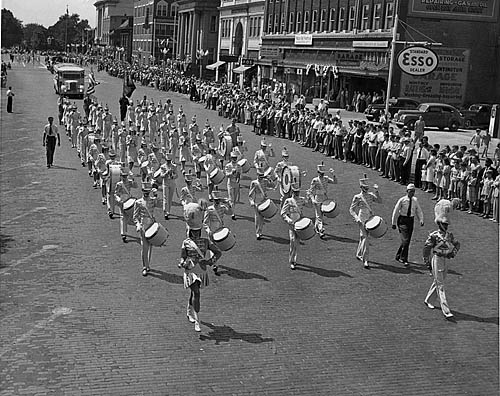Marching to Glory
Bluefield’s American Legion Junior Drum & Bugle Corps
By Stuart McGehee

Bluefield’s American Legion Junior Drum & Bugle Corps marches
through the streets of Huntington, date unknown. The Corps won eight state
championships during the 1930s. Photograph courtesy of the Eastern Regional
Coal Archives.
“I thought it was wonderful. There wasn’t nothing like it,” remembered 73 year-old former Norfolk & Western Railway employee and bass drummer Powell Davis in 1988. “I’d do it again.”
“It was indeed the pride of Bluefield and of West Virginia,” recalled Elizabeth Gearheart in 2004 of the American Legion Junior Drum & Bugle Corps, which brought wide acclaim and national championships to “Nature’s Air Conditioned City.” The Drum & Bugle Corps is a storied component of Bluefield’s unique heritage.
Bluefield was incorporated in 1889, after the N&W chose a blue chicory hued rolling meadow for the site of its flagship Pocahontas Division headquarters. The city grew rapidly as other industries central to the booming “smokeless” coalfields opened up in Mercer, McDowell, and Wyoming counties. The huge N&W roundhouse at Bluefield serviced some of America’s most powerful steam locomotives, hauling high volatile, low sulphur “Fuel Satisfaction,” as the railway termed its principal cargo.
By the 1930's, some 25,000 people lived in West Virginia’s highest-elevated municipality. Scores of nearby company towns depended upon Bluefield as the wholesale center, utility capital, and entertainment draw, and the city’s adoption in 1921 of a city manager form of government displayed its progressive nature. The construction of the 12-story West Virginian Hotel, the tallest building in the state south of Charleston, crowned the central business district, signaling Bluefield’s meteoric rise to prominence in the Mountain State. [See “Bluefield’s Biggest: The Grand West Virginian Hotel,” by Stuart McGehee; Summer 1993.] The city enthusiastically sent soldiers to the Spanish American War and the Great War, as we termed World War I in the inter war decades.
The Depression slowed the coal industry down, and Bluefield’s growth was hampered, but the city’s aggressive, booster minded business community, led by the Chamber of Commerce’s indefatigable Eddie Steele and the Pocahontas Operators Association’s W.E.E. Koepler, fought back. One surviving result of this militant defense against the vagaries of the national economy is the famous “Lemonade Stunt,” where the city still pours free lemonade on the rare days when the Fahrenheit tops 90 degrees. [See “Free Drinks in Nature’s Air-Condition City: Bluefield’s Lemonade Escapades,” by Stuart McGehee; Summer 1997.]
Another such 1930's era community effort was the establishment of the American Legion Junior Drum & Bugle Corps, a marching band destined for two decades of glory. Strict rules determined who enrolled: boys first in 1931, girls added in 1935. The Corps was open to anyone aged 10 to 16, as long as, of course, they were white. This was, after all, decades prior to racial integration. In time, the group fielded more than 100 smartly dressed, crisply striding musicians in complex formations and parades. Local veterans’ organization American Legion Post 9 sponsored the outfit, which wore white-and-gold uniforms for daytime performances, and show stopping coal mining coveralls and carbide-lamp helmets on loan from the Pocahontas Fuel Company for evening events. Their carefully choreographed headlamp twirling routine was a crowd pleaser everywhere they marched.
You can read the rest of this article in this issue of Goldenseal, available in bookstores, libraries or direct from Goldenseal.